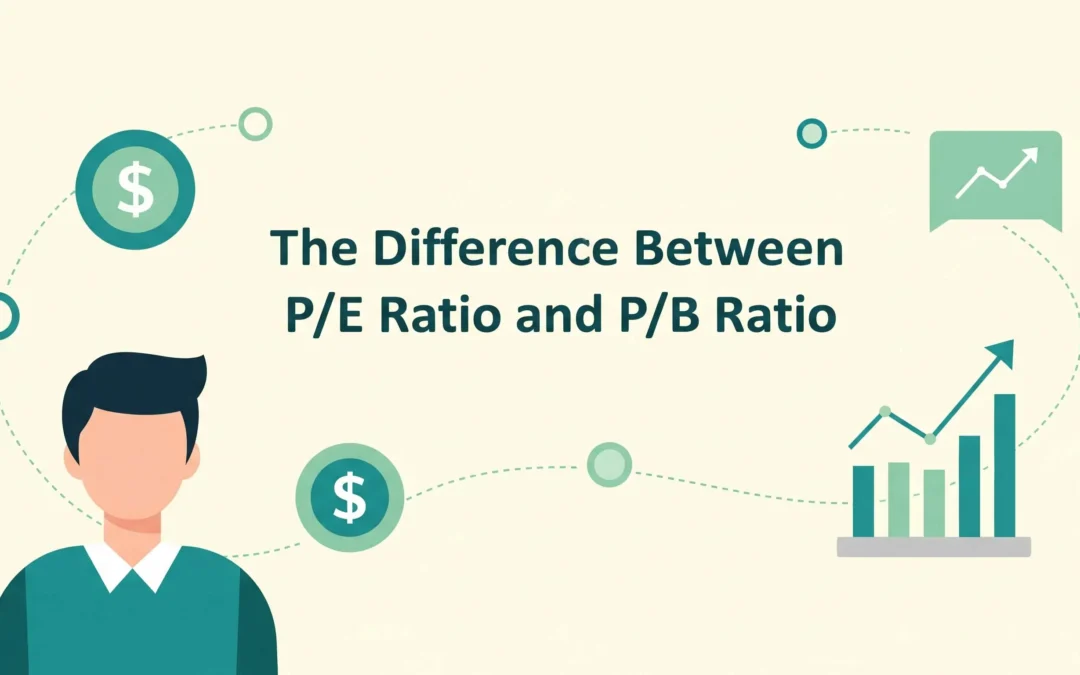Financial ratios represent the position of the company. They help us know how much the company is earning and what its growth potential is. Understanding P/E and P/B ratios is essential as they are easy to use and are commonly used. They are of utmost importance for long-term investors who focus on the fundamentals of the company.
This article with elaborate on both the ratios and help you understand in simple terms about the use of these ratios along with their pros and cons.
Understanding P/E Ratio
The P/E ratio shows the relationship between price and earnings and shows the profitability of the company.
Key Features:
- This ratio mainly measures how much investors are willing to pay for each rupee of the company’s earnings, helping to assess whether a stock is overvalued or undervalued.
- It often reflects investor expectations about the company’s future growth prospects, with higher P/E ratios usually indicating higher anticipated growth.
- It is helpful for comparing businesses in the same industry.
- It is not relevant for a loss-making company.
- A P/E ratio between 15 and 25 is often considered typical, but an ideal value can vary widely depending on the industry and market conditions.
P/E Ratio = Market Price per Share / Earnings per Share (EPS)
For example,
a company with a market price of Rs. 300 and an EPS of Rs. 12, then the P/E ratio is = 300/12 = 25.
The company has a good ratio as it ranges between 15 to 25.
| Basis | Description |
| What it measures | Price relative to earnings |
| Ideal for | Growth-oriented, profitable firms |
| Interpretation | High P/E = optimism, Low P/E = undervaluation |
| Sector examples | IT, FMCG, Pharmaceuticals |
| Caution | Avoid using for loss-making firms. |
Let us now look at the pros and cons of the P/E ratio:
Pros:
- Easy to Use: It is widely accepted in investment analysis and is simple to calculate.
- Reflects Market Expectations: It indicates the expectation of the investor by price that they are willing to pay for anticipated future profits.
- Beneficial for Growth Stocks: Perfect for businesses in developing industries like technology, fast-moving consumer goods, or pharmaceuticals.
- Aids in Peer Comparison: Beneficial for evaluating stocks in the same sector according to profitability.
Cons:
- It is not applicable to loss-making businesses. When EPS is negative or close to zero, it cannot be used.
- May Be Deceptive: The ratio may be distorted by earnings manipulation or one-time revenue.
- Ignores Asset Strength: Does not take into consideration the true book value or net worth of the business.
Understanding P/B Ratio
The P/B ratio represents the relationship between price and the book value of the company. It mainly focuses on the assets of the company.
Key Features:
- Highlights the company’s asset base.
- Perfect for financial or capital-intensive businesses.
- Helps to identify undervalued stocks.
- It may fail to consider intangible assets, such as intellectual property or brand value.
- A P/B ratio below 3 is generally seen as reasonable, but what is considered favourable depends on the sector and the company’s specific circumstances.
P/B Ratio = Market Price per Share / Book Value per Share
For example,
consider a company with a market price of Rs. 273 and a book value of Rs. 97.5. Then the ratio is 273/97.5 = 2.8
It may be considered a favourable ratio as it is below 3. However, to draw a conclusion, it is important to look into other factors and compare them with other companies in the same industry.
| Basis | Description |
| What it measures | Price relative to net asset value |
| Ideal for | Banks, real estate, and capital goods |
| Interpretation | P/B < 1 may suggest the stock is undervalued compared to its assets, while P/B > 3 could indicate potential overvaluation, but these benchmarks should always be compared with industry averages. |
| Sector examples | Banking, Infrastructure, Manufacturing |
| Caution | Less useful for tech/startups with intangible assets |
Let us now closely understand the pros and cons of the P/B ratio:
Pros:
- Emphasis on Asset Valuation: Perfect for businesses like banks or infrastructure companies that have robust balance sheets.
- Highlights Undervalued Stocks: A stock that is trading below its intrinsic value may have a low P/B ratio (less than 1).
- Stable in Volatile Markets: Not as impacted by the changes in earnings as the P/E ratio.
- Helpful in Liquidation Analysis: Indicates the assets’ potential recovery value in the event of a company’s liquidation.
Cons:
- Less Helpful for Asset-Light Businesses: Doesn’t function well for businesses that provide intangible services or assets, like tech startups.
- Ignores Future Profit Potential: Doesn’t account for profitability or earnings growth.
- Book Value May Be Outdated: Because of historical accounting or depreciation, book value may not accurately reflect current market conditions.
Comparison Between P/E Ratio and P/B Ratio
Let us look at the comparison table between both of them for a clear understanding:
| Criteria | P/E Ratio | P/B Ratio |
| Full Form | Price-to-Earnings Ratio | Price-to-Book Value Ratio |
| Formula | Market Price per share ÷ Earnings per Share (EPS) | Market Price per share ÷ Book Value per Share |
| Focus Area | Valuation based on earnings | Net Assets / Book Value |
| Best Suited For | Profit-generating companies (e.g., IT, FMCG) | Asset-heavy companies (e.g., Banks, Manufacturing) |
| Interpretation | Shows how much investors pay per ₹1 of earnings | Shows how much investors pay per ₹1 of net assets |
| Ideal Range in India | 15–25 (sector-specific) | 1–3 (sector-specific) |
| Not Useful | For loss-making or volatile-earnings firms | For asset-light companies with high intangibles |
| Investor Insight | Future growth potential and market sentiment | Financial safety and balance sheet strength |
| Limitation | Affected by accounting changes, temporary profits/losses | May undervalue firms with strong brands or intangible value |
| Common Use Case | Comparing profitability across peers | Valuing companies during downturns or financial distress |
Bottomline
The conclusion can be drawn that both P/E and P/B ratios are important for the fundamental analysis of the company. These ratios help investors understand how the market values a company’s earnings and assets, and whether a stock might be overvalued or undervalued compared to its peers.
For investors, it is important to thoroughly perform analysis before deciding whether to invest or not. Even though these ratios are important and play an important role, it is important to look at other factors as well. Ratios alone may not be able to give a clear picture of the company or industry.


